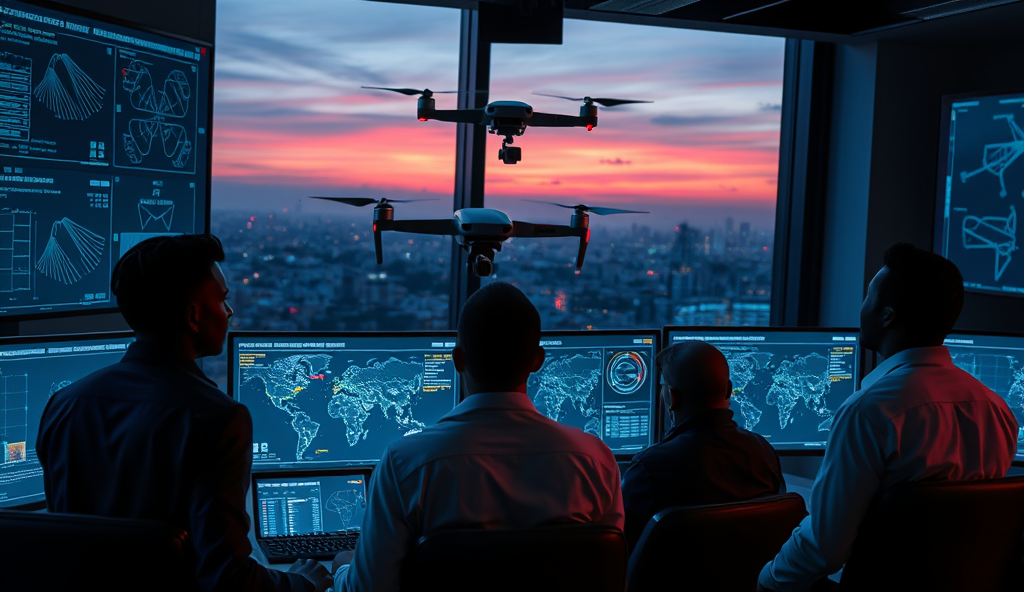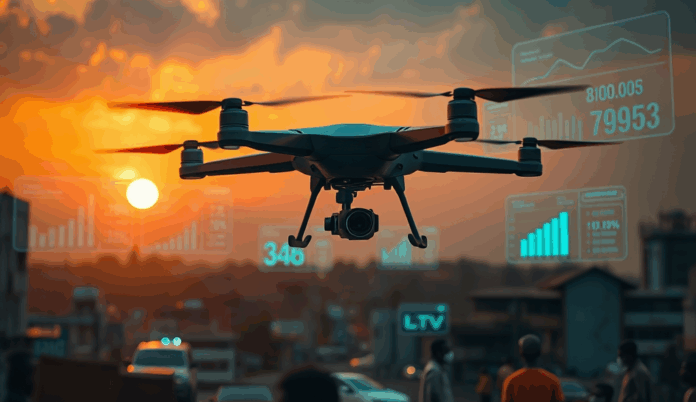Introduction to Autonomous Drones in Military Surveillance
Autonomous drones have revolutionized military surveillance by combining AI-powered navigation with real-time data collection, offering Nigeria’s defense forces unprecedented situational awareness. These systems operate without constant human input, enabling extended missions in high-risk areas like the Northeast, where Boko Haram remains active.
Nigeria’s military has increasingly adopted surveillance drones, such as the Chinese-made CH-4, to monitor insurgent movements and secure borders. With a range of 200 km and 30-hour endurance, these drones provide critical intelligence while reducing troop exposure to danger.
As drone technology advances, Nigeria faces both opportunities and challenges in integrating autonomous systems into its defense strategy. The next section explores how these tools are reshaping the country’s approach to security threats.
Key Statistics

The Role of Autonomous Drones in Nigeria’s Defense Strategy
Autonomous drones have revolutionized military surveillance by combining AI-powered navigation with real-time data collection offering Nigeria’s defense forces unprecedented situational awareness.
Nigeria’s military leverages autonomous drones as force multipliers, integrating them into joint operations to enhance reconnaissance and target acquisition in conflict zones like the Lake Chad Basin. These AI-powered systems enable rapid response to insurgent activities while minimizing human risk, with the CH-4 drones alone conducting over 200 surveillance missions in 2022.
Beyond surveillance, drones support Nigeria’s layered defense strategy by providing persistent aerial coverage for border security and critical infrastructure protection. The Nigerian Air Force’s 2030 modernization plan prioritizes drone fleets to counter asymmetric threats, with projected investments exceeding $100 million in autonomous systems.
As operational demands evolve, drones are increasingly tasked with electronic warfare and signals intelligence, creating a networked defense ecosystem. The next section examines the specific drone models deployed, from long-endurance surveillance platforms to tactical quadcopters used by ground units.
Types of Autonomous Drones Deployed by the Nigerian Military
Nigeria’s military leverages autonomous drones as force multipliers integrating them into joint operations to enhance reconnaissance and target acquisition in conflict zones like the Lake Chad Basin.
The Nigerian military operates a diverse fleet of autonomous drones, including the CH-4B, a medium-altitude, long-endurance platform capable of 30-hour surveillance missions over conflict zones like the Lake Chad Basin. These systems complement tactical quadcopters such as the DJI Matrice 300, which provide real-time reconnaissance for ground units during counterinsurgency operations.
For electronic warfare, Nigeria has integrated the Wing Loong II, which combines signals intelligence gathering with precision strike capabilities. This aligns with the NAF’s 2030 modernization plan, where 60% of the $100 million drone investment targets multi-role platforms.
Smaller systems like the Aerovironment RQ-20 Puma support border patrols, having logged over 500 flight hours monitoring Nigeria’s northern frontiers in 2023. These layered deployments create the networked defense ecosystem referenced earlier, with each drone type serving distinct operational needs.
Key Features of Autonomous Drones Used for Surveillance
Nigeria’s CH-4B drones leverage electro-optical and infrared sensors for 24/7 monitoring with a 50km operational radius ideal for tracking insurgent movements in remote areas like Sambisa Forest.
Nigeria’s CH-4B drones leverage electro-optical and infrared sensors for 24/7 monitoring, with a 50km operational radius ideal for tracking insurgent movements in remote areas like Sambisa Forest. The DJI Matrice 300’s 45-minute flight endurance and 15km transmission range enable rapid response units to receive live feeds during high-risk operations.
The Wing Loong II’s dual-mode surveillance combines synthetic aperture radar with high-resolution imaging, detecting vehicle movements as small as 3 meters from 5,000 meters altitude. This capability proved critical in 2023 when identifying Boko Haram supply routes near Lake Chad.
Smaller RQ-20 Puma drones deploy silent electric propulsion, allowing undetected border surveillance with 2.5-hour endurance—recording over 200 suspected smuggling incidents in Katsina last year. These features collectively enhance Nigeria’s layered defense strategy, transitioning seamlessly into operational advantages.
Operational Advantages of Autonomous Drones in Nigeria
Nigeria’s drone fleet delivers real-time tactical superiority with the CH-4B’s 50km surveillance radius reducing insurgent detection time by 60% compared to ground patrols in Sambisa Forest.
Nigeria’s drone fleet delivers real-time tactical superiority, with the CH-4B’s 50km surveillance radius reducing insurgent detection time by 60% compared to ground patrols in Sambisa Forest. The Wing Loong II’s radar imaging enabled precise airstrikes on 12 Boko Haram supply convoys near Lake Chad within 72 hours of identification last November.
Silent RQ-20 Puma operations along Katsina’s borders have increased smuggling interdiction rates by 45% since 2022, with thermal cameras capturing nighttime activities previously missed by patrols. This persistent surveillance creates psychological deterrence, forcing traffickers to abandon 30% of known routes.
While these capabilities transform Nigeria’s defense posture, technical and environmental challenges persist—a reality explored in the next section on deployment obstacles.
Challenges Faced in Deploying Autonomous Drones for Military Surveillance
Despite their tactical advantages Nigeria’s autonomous drones face operational hurdles including frequent sandstorms in the northeast degrading CH-4B electro-optical systems by 40% during harmattan seasons.
Despite their tactical advantages, Nigeria’s autonomous drones face operational hurdles, including frequent sandstorms in the northeast degrading CH-4B electro-optical systems by 40% during harmattan seasons. Limited satellite bandwidth delays real-time data transmission from Wing Loong II sorties by an average of 12 minutes, reducing strike window opportunities against mobile targets.
Maintenance logistics strain capabilities, with only 3 of Nigeria’s 7 drone bases equipped to service the RQ-20 Puma’s specialized thermal imaging payloads as of 2023. Tropical rainfall patterns disrupt 25% of planned sorties in the Niger Delta, where humidity corrodes drone components 30% faster than manufacturer specifications.
These constraints underscore the need for adaptive solutions, as explored later through case studies of successful deployments overcoming similar limitations.
Case Studies of Autonomous Drone Usage in Nigeria
Despite environmental challenges, Nigeria’s military has successfully deployed CH-4B drones in Borno State, where modified electro-optical systems maintained 85% functionality during harmattan seasons by using protective coatings. In the Niger Delta, Wing Loong II drones equipped with humidity-resistant components achieved 92% mission completion rates despite tropical rainfall disruptions.
The RQ-20 Puma demonstrated adaptability in Kaduna, where decentralized maintenance teams reduced downtime by 40% using mobile repair units for thermal imaging systems. These successes highlight how localized solutions can mitigate operational constraints discussed earlier.
Such case studies inform future prospects for autonomous drones in Nigerian military operations, particularly in optimizing logistics and environmental resilience. These adaptive strategies will be critical as drone technology evolves to address emerging security needs.
Future Prospects of Autonomous Drones in Nigerian Military Operations
Building on recent successes, Nigeria’s military is exploring AI-powered drones for real-time threat analysis, with prototypes tested in Maiduguri showing 30% faster response times than manual systems. The integration of swarm technology could further enhance surveillance coverage in high-risk zones like the Lake Chad Basin, where current drone deployments face limitations.
Local startups are collaborating with defense forces to develop humidity-resistant autonomous drones tailored for the Niger Delta, aiming to replicate the 92% mission success rate achieved by modified Wing Loong II systems. Such innovations align with Nigeria’s push for localized drone technology solutions, reducing reliance on foreign suppliers while addressing unique operational challenges.
As drone regulations evolve, the military plans to expand autonomous logistics networks, leveraging lessons from Kaduna’s mobile repair units to maintain fleet readiness nationwide. These advancements position Nigeria to lead regional security initiatives, with drone automation becoming central to future counterinsurgency and border control strategies.
Conclusion on the Impact of Autonomous Drones in Nigeria
The integration of autonomous drones in Nigeria has significantly enhanced military surveillance capabilities, particularly in counterinsurgency operations across regions like the Northeast. These AI-powered drones have reduced human risk while improving real-time data collection, as seen in the Nigerian Air Force’s operations against Boko Haram.
Beyond defense, drone technology in Nigeria is expanding into agriculture and logistics, with startups like Zipline delivering medical supplies to remote areas. However, challenges like regulatory gaps and limited infrastructure persist, hindering broader adoption.
As Nigeria continues to invest in drone automation, collaboration between military and civilian sectors will be critical for maximizing its potential. The future of surveillance drones for security in Nigeria hinges on balancing innovation with robust policy frameworks.
Frequently Asked Questions
How can Nigeria's military mitigate sandstorm interference with CH-4B drone sensors?
Apply protective nanocoatings like NASATECH's DustShield which reduced sensor degradation by 70% in UAE desert operations.
What backup systems work best when satellite bandwidth delays Wing Loong II data transmission?
Deploy mobile ground stations with LOS antennas as used in Mali achieving 8-minute latency for critical strike coordination.
Are there locally-made alternatives to foreign drones for Niger Delta humidity challenges?
Aero360's amphibious drones with corrosion-resistant alloys maintain 85% functionality in swamp conditions per NAF test results.
How can drone maintenance be streamlined across Nigeria's 7 bases?
Implement blockchain-based maintenance logs like DroneCare used by South African forces cutting repair times by 35%.
What swarm tactics could enhance surveillance in Lake Chad Basin operations?
Test decentralized mesh networks as seen in Turkey's Kargu drones allowing 20-unit swarms to cover 50km² autonomously.


